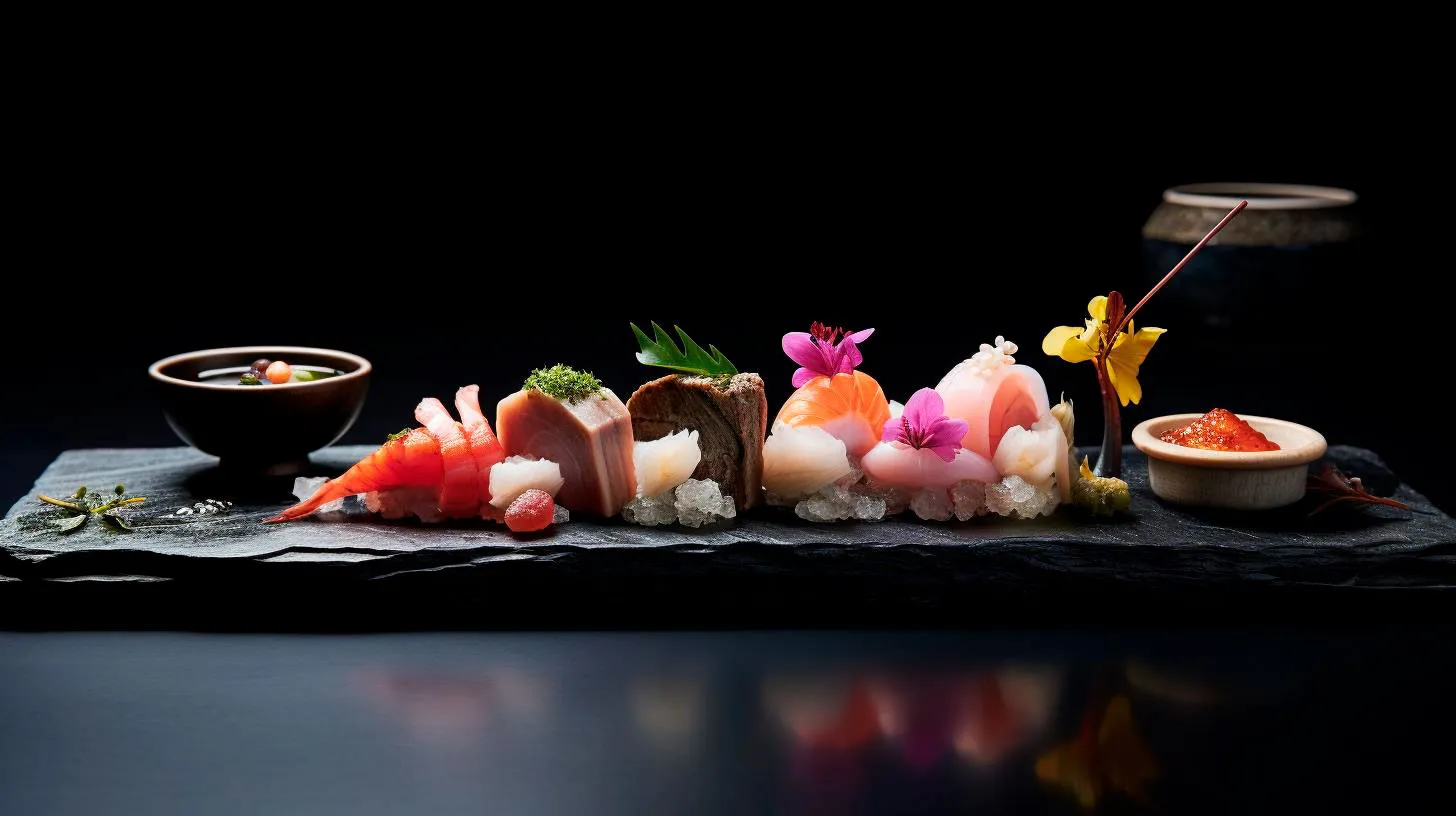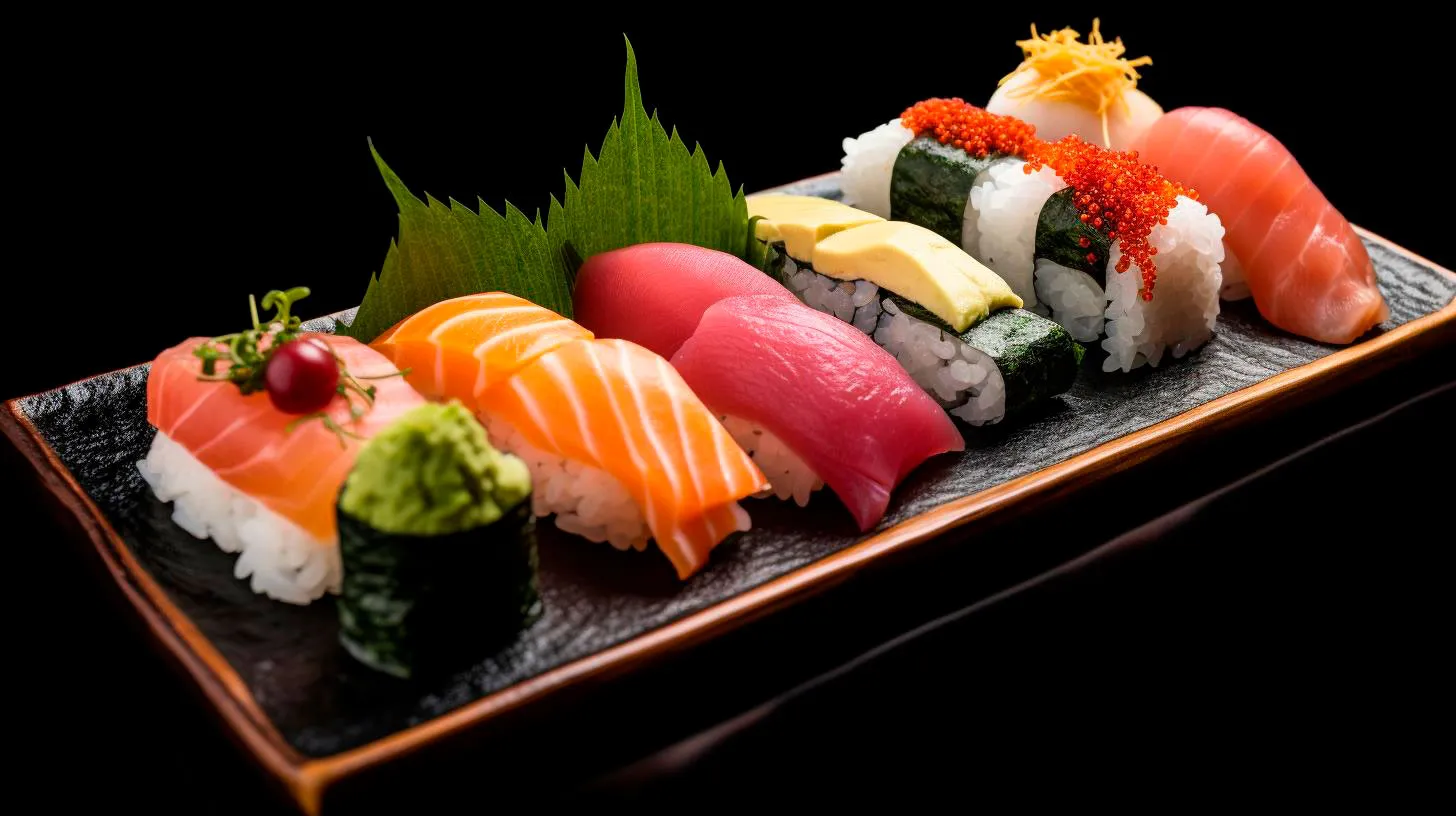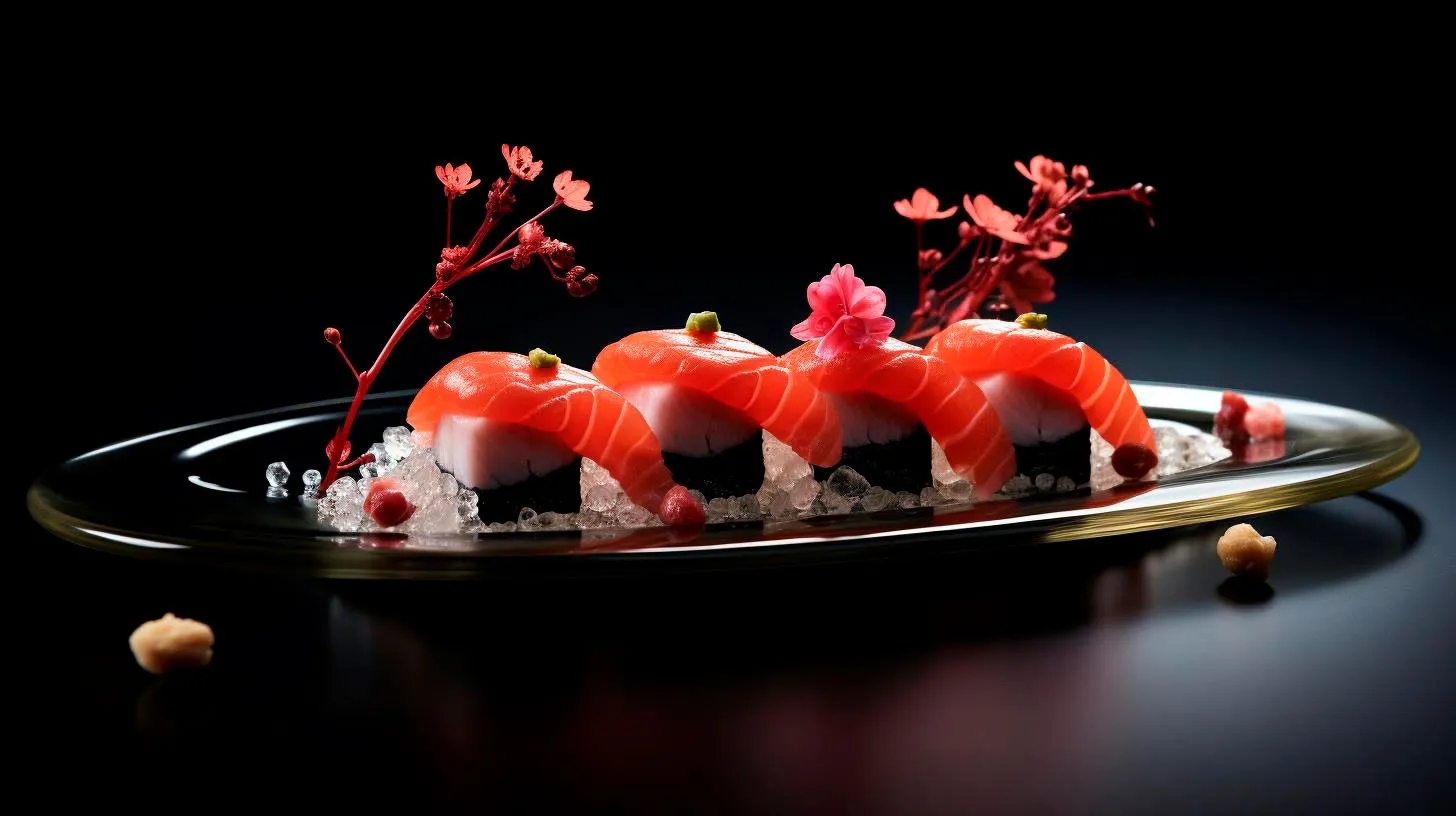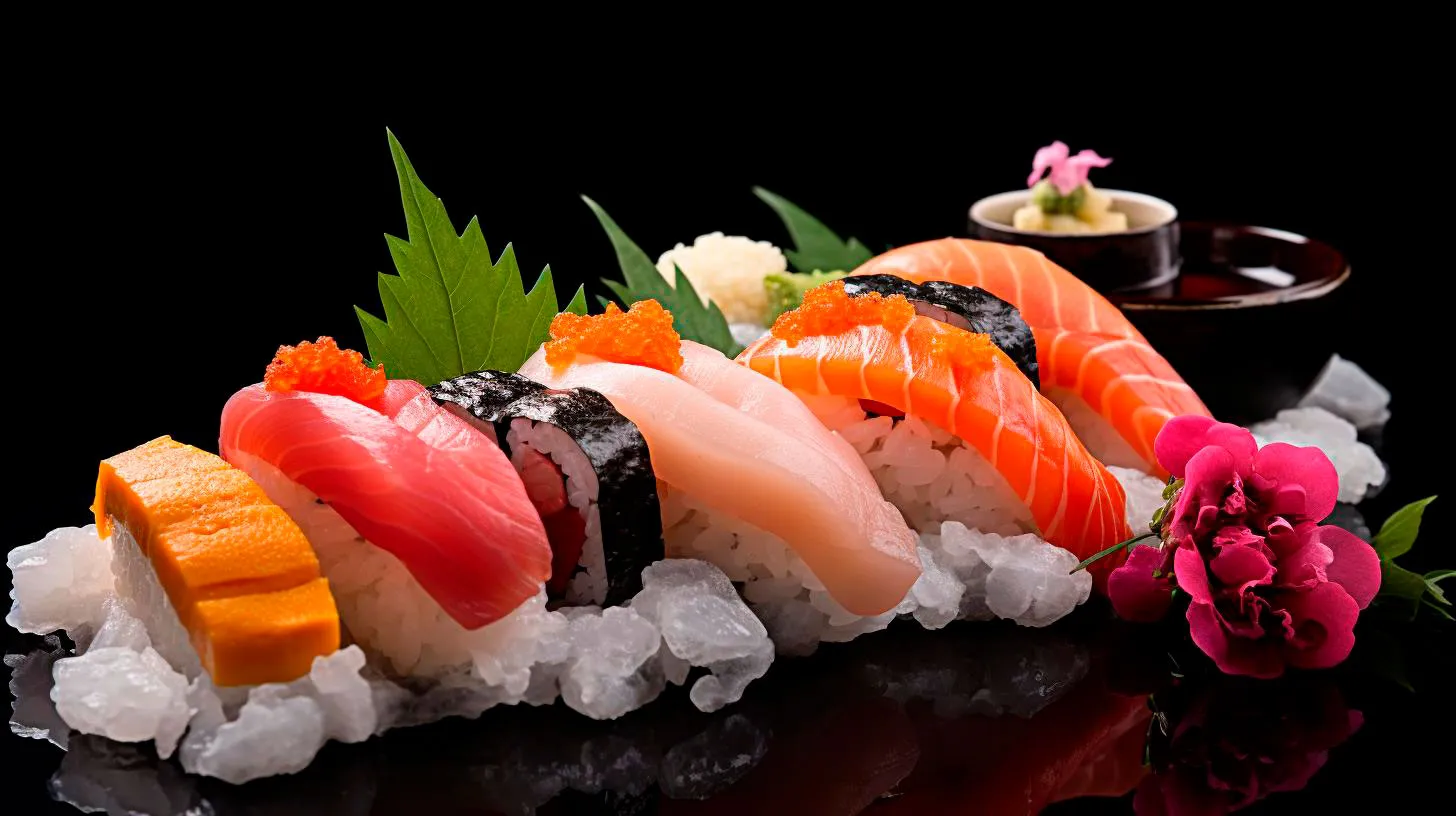From Culinary Schools to Canvas: Exploring the Fusion of Sushi and Art
This unique relationship between two distinct forms of expression has given rise to a captivating and visually appealing dining experience.
Sushi as Edible Art
Sushi, a traditional Japanese dish consisting of vinegared rice and various toppings, has long been revered for its artistic presentation. Sushi chefs, known as Itamae, meticulously craft each piece with precision and attention to detail. From the vibrant colors of the ingredients to the symmetrical arrangement on the plate, sushi has the ability to captivate diners even before they take their first bite.
However, in recent years, sushi has evolved beyond traditional plating into a form of edible art. Chefs have started embracing their creativity and transforming sushi into unique masterpieces. Here are some notable features of sushi as edible art:
- Delicate and intricate designs created using various ingredients
- Playful arrangements resembling animals, flowers, or even famous landmarks
- Impeccable attention to detail, with each piece carefully crafted to evoke visual delight
- Harmonious combination of colors and textures to enhance the overall aesthetic appeal
This fusion of culinary expertise and artistic expression has elevated sushi from mere cuisine to a multisensory experience that engages both taste buds and eyes.
Art-Inspired Sushi Creations
Inspired by various art forms, sushi chefs have started to incorporate artistic motifs and techniques into their creations. By drawing inspiration from famous paintings, sculptures, and even street art, they infuse their sushi with an extra layer of creativity and uniqueness. Some notable examples include:
- Van Gogh Rolls: These sushi rolls are inspired by the iconic brushstrokes seen in Vincent van Gogh’s paintings. By carefully layering colorful ingredients, sushi chefs create visually striking pieces that pay homage to the artist’s masterful swirls.
- Kusama Nigiri: Taking inspiration from Japanese artist Yayoi Kusama’s distinctive polka dot and infinity mirror patterns, sushi chefs incorporate the vibrant and repetitive designs onto individual pieces of nigiri. The result is a visually mesmerizing sushi experience.
- Graffiti Sashimi: Embracing the urban art scene, some sushi chefs experiment by using vibrant sauces and garnishes to create graffiti-inspired designs on sashimi platters. These unconventional creations often showcase the chef’s ability to blend flavors and colors into visually appealing edible art.
By incorporating elements of art into sushi, chefs not only showcase their culinary skills but also provide diners with a unique and thought-provoking experience that goes beyond the traditional notions of food.
The Intersection of Sushi and Canvas
While sushi has embraced its artistic side, art has also found its way onto the canvas through sushi. In recent years, a trend has emerged where sushi chefs collaborate with artists to create stunning edible masterpieces that blur the lines between food and art.
Some key takeaways from the intersection of sushi and canvas include:
- Ephemeral Art: The collaborative creations between sushi chefs and artists are often short-lived, as the sushi components need to be consumed to fully appreciate the artistry. This makes these creations all the more special, elevating them to the realm of temporary, ephemeral art.
- Mutual Inspiration: Both sushi chefs and artists draw inspiration from each other’s worlds, leading to the creation of unique and boundary-breaking pieces. The fusion of culinary expertise and artistic vision sparks creativity and pushes the boundaries of what is possible in both fields.
- Shared Experiences: The collaboration between sushi chefs and artists provides diners with an opportunity to engage with art in a new and interactive way. By encouraging them to fully appreciate the visual aspects of their food, this fusion demonstrates the power of art to evoke emotions and connect people.
Ultimately, the fusion of sushi and art serves as a reminder that creativity knows no limits, and culinary experiences can be elevated to new heights through collaboration and imagination.
The Future of Sushi and Art
As sushi continues to captivate the culinary world, and art garners appreciation from all corners of society, the fusion of these two forms of expression is likely to thrive. The convergence of the sushi and art worlds offers endless opportunities for experimentation, innovation, and mind-bending creations.
Key advancements and trends to look out for in the future include:
- Technological Marvels: With the advancements in food technology, sushi chefs may soon incorporate edible ink printers and 3D printing techniques to create intricate designs and textures. This convergence of technology and artistry could take sushi to a whole new level.
- Sustainability and Conservation: As environmental concerns grow, sushi chefs and artists may collaborate to spread awareness about the importance of sustainable fishing practices through their creations. These edible art pieces could serve as a catalyst for change.
- Social Media Sensations: The visually captivating nature of sushi and art fusions makes them highly shareable on social media platforms. Chefs and artists may harness this trend by creating signature dishes that are not only delicious but also Instagrammable works of art.
Exciting times lie ahead for the fusion of sushi and art, as boundaries continue to be shattered and new possibilities emerge. By embracing creativity and collaboration, the culinary and artistic worlds can embark on a journey that tantalizes the taste buds and captivates the imagination.
The Artistic Side of Sushi: How Culinary Schools Embrace Sushi Artistry
In this article, we explore how culinary schools embrace the artistic side of sushi and contribute to the growth of this captivating culinary tradition.
The Fusion of Tradition and Creativity
Sushi is a harmonious fusion of tradition and creativity. While it is important to respect the traditional techniques and ingredients, sushi artistry allows chefs to showcase their innovative skills through unique presentations and flavor combinations. Culinary schools are now incorporating specialized classes or workshops focused on sushi artistry, encouraging students to explore their creative side without compromising the authentic essence of sushi.
Key takeaways:
- Culinary schools have recognized the need to teach sushi artistry.
- Sushi artistry encourages creativity while respecting tradition.
- Students are given the opportunity to explore unique presentations and flavors.
The Importance of Aesthetics in Sushi Artistry
In sushi artistry, aesthetics play a crucial role. The presentation of sushi is as important as its taste, and chefs meticulously craft each piece with precision. Culinary schools emphasize the importance of visual appeal by teaching students how to create visually stunning compositions using vibrant colors, contrasting textures, and decorative garnishes. The goal is to create a feast for the eyes, enhancing the overall dining experience.
Key takeaways:
- Aesthetics are vital in sushi artistry.
- Culinary schools teach students how to create visually stunning compositions.
- Colors, textures, and garnishes are used to enhance the visual appeal of sushi.
The Role of Knife Skills in Sushi Artistry
Knife skills are an essential part of sushi artistry. The precision and technique used to slice the fish and vegetables contribute to the overall aesthetics and texture of the sushi. Culinary schools focus on teaching students the art of knife handling, helping them master the delicate and intricate cuts required for sushi preparation. Through practice and guidance, students develop the necessary skills to create beautifully crafted sushi pieces.
Key takeaways:
- Knife skills are crucial in sushi artistry.
- Culinary schools train students in the art of knife handling.
- Precision cuts contribute to the aesthetics and texture of sushi.
Sustainability and Sushi Artistry
As the world becomes increasingly concerned about sustainability, culinary schools are incorporating lessons on responsible sourcing and sustainability within sushi artistry classes. Students are educated about the importance of using sustainable seafood, supporting local fisheries, and practicing responsible fishing methods. By imparting these values, culinary schools contribute to the preservation of sushi’s traditional roots and its availability for future generations.
Key takeaways:
- Culinary schools educate students on responsible sourcing and sustainability.
- The focus is on using sustainable seafood and supporting local fisheries.
- Preserving sushi’s traditional roots is crucial for future generations.
The Growing Demand for Sushi Artistry
Sushi artistry has gained immense popularity in recent years, both among food enthusiasts and professional chefs. The demand for sushi artistry extends beyond traditional Japanese restaurants, with contemporary fusion cuisine embracing the art form. By offering specialized training in sushi artistry, culinary schools enable aspiring chefs to meet the evolving demands of the industry, enhancing their career prospects and opening doors to diverse culinary experiences.
Key takeaways:
- Sushi artistry is in high demand among food enthusiasts and chefs.
- Contemporary fusion cuisine incorporates sushi artistry.
- Culinary schools provide specialized training to meet industry demands.
In Conclusion
Sushi artistry is a captivating blend of tradition, creativity, and visual appeal. Culinary schools have recognized the significance of embracing sushi artistry as part of their curriculum, enabling students to explore their creativity while respecting the authentic essence of sushi. By focusing on aesthetics, knife skills, sustainability, and the growing demand for sushi artistry, culinary schools contribute to the growth and preservation of this exquisite culinary tradition. So, whether you’re a food enthusiast or a budding chef, exploring the artistic side of sushi will undoubtedly elevate your culinary journey to new heights.
Mastering the Art of Sushi Craftsmanship: A Growing Trend in Culinary Education
Sushi craftsmanship, or “sushi-ku,” goes beyond merely rolling rice and fish together. It involves precision, artistry, and a deep understanding of ingredients. Many culinary schools and workshops have recognized the growing interest in sushi and are now offering specialized courses to educate aspiring chefs in this unique craft.
Why Learn Sushi Craftsmanship?
Deciding to learn the art of sushi craftsmanship can offer aspiring chefs a range of benefits and opportunities. Let’s explore some of the reasons why this growing trend in culinary education is worth considering:
- Global Demand: With sushi’s popularity on the rise, the demand for skilled sushi chefs is soaring. By mastering the art of sushi craftsmanship, you’ll open doors to exciting career opportunities worldwide.
- Cultural Appreciation: Sushi is deeply rooted in Japanese culture. By learning this art form, you’ll gain a deeper appreciation for Japanese traditions, ingredients, and culinary techniques.
- Creative Expression: Sushi craftsmanship allows for immense creativity. From choosing the freshest ingredients to creating visually stunning rolls, you can showcase your artistic flair and culinary skills.
- Health Benefits: Sushi is known for its health benefits, as it often includes nutrient-rich ingredients like fish, seaweed, and vegetables. Becoming proficient in crafting sushi enables you to create nourishing and delicious meals.
Key Takeaways from Sushi Craftsmanship Courses
Enrolling in a sushi craftsmanship course can provide you with invaluable knowledge and skills. Here are some key takeaways you can expect:
1. Understanding the Ingredients:
A crucial aspect of sushi craftsmanship is acquiring in-depth knowledge about various ingredients. You’ll learn about different types of rice, fish, seaweed, and fillings, as well as how to select the freshest and best-quality ingredients available.
2. Knife Skills:
Mastering the art of sushi requires exceptional knife skills. In a sushi craftsmanship course, you’ll learn how to handle and care for traditional Japanese knives, ensuring precision cuts and impeccable presentation.
3. Sushi Rolling Techniques:
Rolling sushi is an art in itself, and a sushi craftsmanship course will teach you various rolling techniques, such as hosomaki (thin rolls), futomaki (thick rolls), and uramaki (inside-out rolls). You’ll learn to create visually appealing rolls that are both tasty and aesthetically pleasing.
4. Presentation and Plating:
In the culinary world, presentation is key, and sushi is no exception. You’ll discover the art of presenting sushi beautifully, using garnishes, sauces, and decorative elements. This skill will elevate your culinary creations and leave a lasting impression on diners.
5. Sushi Etiquette:
Learning sushi craftsmanship also involves understanding the etiquette and cultural norms associated with sushi consumption. You’ll gain insights into the traditions and customs surrounding sushi, ensuring that you serve and enjoy this delicacy in the most authentic way possible.
The Future of Sushi Craftsmanship
As the popularity of sushi continues to grow, so does the demand for skilled sushi craftsmen. The future of sushi craftsmanship looks incredibly promising, with opportunities for chefs to showcase their talent both in traditional Japanese restaurants and fusion culinary establishments.
Moreover, technological advancements and globalization have made sushi ingredients more accessible worldwide, allowing chefs to experiment with different flavors and styles. This evolution paves the way for innovation in sushi craftsmanship, encouraging chefs to push boundaries and create unique sushi experiences.
In conclusion, mastering the art of sushi craftsmanship has become a growing trend in culinary education. By enrolling in a sushi craftsmanship course, you’ll gain a deep understanding of ingredients, develop exceptional knife skills, learn various rolling techniques, and understand the intricacies of sushi presentation and etiquette. With the demand for skilled sushi craftsmen on the rise, embarking on this culinary journey can open doors to exciting career opportunities while allowing you to express your creativity and appreciation for Japanese culture.
Fueling Creativity: Sushi Art Sparks Interest in Culinary Schools
In this article, we will explore the unique fusion of creativity and culinary skills in sushi art, its advantages, and the key takeaways that aspiring culinary students can gain from this fascinating trend.
The Rise of Sushi Art
Sushi, once viewed as a simple dish of raw fish and vinegared rice, has now become a canvas for chefs to showcase their artistic prowess. This evolution can be attributed to the rise of social media platforms, such as Instagram, where visually stunning food creations have gained immense popularity. Sushi art takes traditional sushi rolls and elevates them to the level of edible masterpieces. Chefs use a variety of techniques, including intricate cutting, shaping, and arranging of ingredients to create visually striking pieces of culinary art.
Some key features of sushi art include:
- Elaborate and intricate designs using various ingredients
- Attention to detail in cutting, shaping, and arranging the sushi
- Incorporation of vibrant colors and contrasting textures
The advantages of sushi art go beyond its visual appeal. Let’s explore why it has become a driving force in culinary education and what aspiring chefs can learn from this innovative trend.
Advantages of Sushi Art in Culinary Education
1. Fusion of Creativity and Technique
Sushi art combines the technical skills of traditional sushi-making with artistic creativity. Aspiring culinary students who venture into sushi art learn to think outside the box while honing their foundational culinary techniques. This fusion allows them to develop a unique skill set that sets them apart from other chefs, equipping them to meet the demands of modern gastronomy.
2. Aesthetic Presentation
In today’s culinary landscape, presentation plays a vital role in the overall dining experience. Sushi art emphasizes the importance of aesthetic appeal, training aspiring chefs to create visually stunning dishes that leave a lasting impression. The ability to present food in an appealing manner is crucial in the competitive world of culinary arts.
3. Culinary Diversity and Cultural Appreciation
Sushi art encourages chefs to explore various culinary traditions and ingredients. By experimenting with different flavors and techniques, culinary students broaden their knowledge of global cuisines. This exposure fosters cultural appreciation and enables chefs to create innovative fusion dishes that cater to diverse palates.
Key Takeaways for Aspiring Culinary Students
For aspiring culinary students interested in sushi art, here are some key takeaways:
- Master foundational culinary techniques before venturing into sushi art.
- Embrace creativity and experiment with various ingredients and flavors.
- Pay attention to detail and refine your cutting and arranging skills.
- Stay updated with the latest culinary trends and technologies.
- Seek inspiration from both traditional and contemporary sushi art.
- Practice and patience are essential to mastering sushi art.
In conclusion, sushi art has sparked immense interest in culinary schools by combining creativity and culinary skills into visually stunning edible masterpieces. Aspiring chefs who venture into sushi art gain a competitive edge in the culinary world, thanks to its fusion of technique and aesthetics. By embracing this innovative trend, culinary students can broaden their culinary diversity, appreciate different cultures, and develop unique skill sets that make them stand out in their culinary careers.



